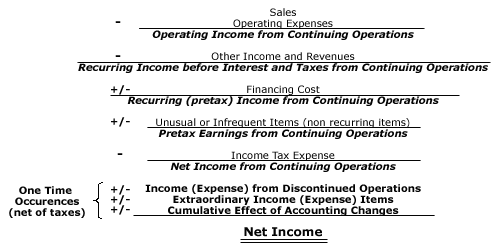CFA Level 1 - Financial Statements
Income Statement Format
The following figure demonstrates which components are used to calculate a company's net income, which is the income available to shareholders.
Figure 6.4: How Net Income is Derived on the Income Statement
The Components of Net Income:
- Operating income from continuing operations - This comprises all revenues net of returns, allowances and discounts, less the cost and expenses related to the generation of these revenues. The costs deducted from revenues are typically the COGS and SG&A expenses.
- Recurring income before interest and taxes from continuing operations - This component includes, in addition to operating income from continuing operations, all other income, such as investment income from unconsolidated subsidiaries and/or other investments and gains (or losses) from the sale of assets. To be included in this category, these items must be recurring in nature. This component is generally considered to be the best predictor of future earning. That said, it does assume that noncash expenses such as depreciation and amortization are a good indicator of future capital expenditures. Since this component does not take into account the capital structure of the company (use of debt), it is also used to value similar companies.
- Recurring (pre-tax) income from continuing operations - This component takes the company's financial structure into consideration as it deducts interest expenses.
- Pre-tax earning from continuing operations - This component considers all unusual or infrequent items. Included in this category are items that are either unusual or infrequent in nature but cannot be both. Examples are an employee-separation cost, plant shutdown, impairments, write-offs, write-downs, integration expenses, etc.
- Net income from continuing operations - This component takes into account the impact of taxes from continuing operations.
Non-Recurring Items
Discontinued operations, extraordinary items and accounting changes are all reported as separate items in the income statement. They are all reported net of taxes and below the tax line, and are not included in income from continuing operations. In some cases, earlier income statements and balance sheets have to be adjusted to reflect changes.
- Income (or expense) from discontinued operations - This component is related to income (or expense) generated due to the shutdown of one or more divisions or operations (plants). These events need to be isolated so they do not inflate or deflate the company's future earning potential. This type of nonrecurring occurrence also has a nonrecurring tax implication and, as a result of the tax implication, should not be included in the income tax expense used to calculate net income from continuing operations. That is why this income (or expense) is always reported net of taxes. The same is true for extraordinary items and cumulative effect of accounting changes (see below).
- Extraordinary items - This component relates to items that are both unusual and infrequent in nature. That means it is a one-time gain or loss that is not expected to occur in the future. An example is environmental remediation.
- Cumulative effect of accounting changes - This item is generally related to changes in accounting policies or estimations. In most cases, these are non cash-related expenses but could have an effect on taxes.







0 comments:
Post a Comment